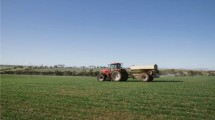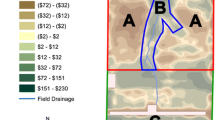Abstract
A survey of Australian grain growers was conducted to gauge grower attitudes to crop and soil sensing and their role in nitrogen fertilizer management. The technologies considered were yield monitors, remote and proximal crop sensing, high resolution soil survey, soil moisture sensing and digital elevation models (DEM). Whereas Australian grain growers have readily adopted machine guidance and autosteer, and a majority have access to yield monitoring, the rate of use of many crop and soil sensors remains comparatively low. However, the survey results suggest a positive effect on sensor adoption through present use of yield mapping. Access to yield maps was significantly associated with the use of remotely sensed imagery, high resolution soil survey, soil moisture sensing, DEM and variable rate application of fertilizers and/or soil amendments. There is some support for proximal crop sensing, albeit with low present rates of use; the use of soil water sensors and DEM is presently very low. For the further development of precision agriculture (PA), the results make clear that expending effort in enhancing the adoption and use of yield maps would be valuable as a lever to gain ‘buy-in’ from growers to sensing and PA more broadly. Since growers use many sources of information to support fertilizer decision-making, any new fertilizer decision aid needs to establish a point of difference from, but be complementary to, existing tools. One way of achieving this would be to use sensors, supported by locally derived algorithms, as a key input to fertilizer decision support.

Map provided courtesy of GRDC
Similar content being viewed by others
References
ABARES (2017). Agricultural commodity statistics 2017. Australian Bureau of Agricultural and Resource Economics and Sciences, Department of Agriculture and Water Resources, Canberra. http://data.daff.gov.au/data/warehouse/agcstd9abcc002/agcstd9abcc0022017_IugZg/ACS_2017_v1.1.0_lr.pdf. Accessed March 2018.
Adams, M. L., Cook, S. E., Caccetta, P. A., & Pringle, M.J. (1999). Machine learning methods in site-specific management research: An Australian case study. In Robert, P. C., Rust, R. H. & Larsen, W. E. (Eds.) Proceedings of the Fourth International Conference on Precision Agriculture (pp. 1321–1333). Madison, WI, USA: ASA-CSSA-SSSA.
Aldana, U., Foltz, J. D., Barham, B. L., & Useche, P. (2010). Sequential adoption of package technologies: The dynamics of stacked trait corn adoption. American Journal of Agricultural Economics, 93, 130–143.
Bramley, R. G. V., & Trengove, S. (2013). Precision Agriculture in Australia: present status and recent developments. Engenharia Agricola, 33, 575–588.
Cann, M. A. (2000). Clay spreading on water repellent sands in the southeast of South Australia—promoting sustainable agriculture. Journal of Hydrology, 231–232, 333–341.
Carberry, P. S., Hochman, Z., McCown, R. L., Dalgliesh, N. P., Foale, M. A., Hargreaves, J. N. G., et al. (2002). The Farmscape approach to decision support: Farmers’, advisers’, researchers’ monitoring, simulation, communication and performance evaluation. Agricultural Systems, 74, 141–177.
Colaço, A. F., & Bramley, R. G. V. (2018). Do crop sensors promote improved nitrogen management in grain crops? Field Crops Research, 218, 126–140.
Cook, S. E., & Bramley, R. G. V. (1998). Precision agriculture—Opportunities, benefits and pitfalls of site-specific crop management in Australia. Australian Journal of Experimental Agriculture, 38, 753–763.
Cook, S. E., Corner, R. J., Riethmuller, G., Mussel, G., & Maitland, M. D. (1996). Precision agriculture and risk analysis: An Australian example. In Robert, P. C., Rust, R. H. & Larsen, W. E. (Eds.) Proceedings of the Third International Conference on Precision Agriculture (pp. 1123–1132). Madison, WI, USA: ASA-CSSA-SSSA.
Corsini, L., Wagner, K., Gocke, A., & Kurth, T. (2015). Crop farming 2030: The reinvention of the sector. Boston: The Boston Consulting Group. https://www.bcg.com/en-au/publications/2015/crop-farming-2030-reinvention-sector.aspx. Accessed March 2018.
Evans, K. J., Terhorst, A., & Ho Kang, B. (2017). From data to decisions: Helping crop producers build their actionable knowledge. Critical Reviews in Plant Sciences, 36, 71–88.
Hall, D. J. M., Jones, H. R., Crabtree, W. L., & Daniels, T. L. (2010). Claying and deep ripping can increase crop yields and profits on water repellent sands with marginal fertility in southern Western Australia. Australian Journal of Soil Research, 48, 178–187.
Hochman, Z., van Rees, H., Carberry, P. S., Hunt, J. R., McCown, R. L., Gartmann, A., et al. (2009). Re-inventing model-based decision support with Australian dryland farmers. 4. Yield Prophet® helps farmers monitor and manage crops in a variable climate. Crop and Pasture Science, 60, 1057–1070.
Keating, B. A., Carberry, P. S., Hammer, G. L., Probert, M. E., Robertson, M. J., Holzworth, D., et al. (2003). An overview of APSIM, a model designed for farming systems simulation. European Journal of Agronomy, 18, 267–288.
Keogh, M., & Henry, M. (2016). The implications of digital agriculture and big data for australian agriculture (p. 68). Research Report, Sydney, Australia: Australian Farm Institute.
Kirkegaard, J. A., Hunt, J. R., McBeath, T. M., Lilley, J. M., Moore, A., Verburg, K., et al. (2014). Improving water productivity in the Australian grains industry—a nationally coordinated approach. Crop and Pasture Science, 65, 583–601.
Lawes, R. A., Oliver, Y. M., & Robertson, M. J. (2009). Integrating the effects of climate and plant available soil water holding capacity on wheat yield. Field Crops Research, 113, 297–305.
Leonard, E., Rainbow, R., Trindall, J., Baker, I., Barry, S., Darragh, L., et al. (2017). Overview—Accelerating precision agriculture to decision agriculture: Enabling digital agriculture in Australia. Narrabri: Cotton Research and Development Corporation. http://farminstitute.org.au/LiteratureRetrieve.aspx?ID=161055. Accessed March 2018.
Llewellyn, R., & Ouzman, J. (2015). Adoption of precision agriculture-related practices: status, opportunities and the role of farm advisers. https://grdc.com.au/__data/assets/pdf_file/0024/208653/adoption-of-precision-agricultural-related-practices-status-opportunities-and-the-role-of-farm-advisers-2014.pdf.pdf. Accessed March 2018.
Llewellyn, R. S., Ronning, D., Ouzman, J., Walker, S., Mayfield, A., & Clarke, M. (2016). Impact of weeds on Australian grain production: The cost of weeds to Australian grain growers and the adoption of weed management and tillage practices. Report for GRDC. CSIRO, Australia. https://grdc.com.au/__data/assets/pdf_file/0027/75843/grdc_weeds_review_r8.pdf.pdf. Accessed March 2018.
Llewellyn, R., Whitbread, A., Jones, B., & Davoren, B. (2008). The role for EM mapping in precision agriculture in the Mallee. In Unkovich, M. (Ed.) Global issues, paddock action. Proceedings of the 14th Australian Agronomy Conference. Gosford, NSW: Australian Society of Agronomy/The Regional Institute Ltd. www.regional.org.au/au/asa/2008/concurrent/managing-site-season/5915_llewellynrl.htm#TopOfPage. Accessed June 2018.
Mark, T. B., Griffin, T. W., & Whitacre, B. E. (2016). The role of wireless broadband connectivity on ‘Big Data’ and the agricultural industry in the United States and Australia. International Food and Agribusiness Management Review, 19(A), 43–56.
McBeath, T. M., Gupta, V. V. S. R., Llewellyn, R. S., Davoren, C. W., & Whitbread, A. M. (2015). Break-crop effects on wheat production across soils and seasons in a semi-arid environment. Crop and Pasture Science, 66, 566–579.
Miller, N. J., Griffin, T. W., Bergold, J., Ciampitti, I. A., & Sharda, A. (2017). Farmers’ adoption path of precision agriculture technology. In Taylor, J. A., Cammarano, D., Prashar, A. & Hamilton, A. (Eds.) Proceedings of the 11th European Conference on Precision Agriculture. Advances in Animal Biosciences: Precision Agriculture (ECPA) 2017 (Vol. 8, No. 2, pp. 708–712).
Paustian, M., & Theuvsen, L. (2017). Adoption of precision agriculture technologies by German crop farmers. Precision Agriculture, 18, 701–716.
Raun, W. R., Solie, J. B., Stone, M. L., Martin, K. L., Freeman, K. W., Mullen, R. W., et al. (2005). Optical sensor-based algorithm for crop nitrogen fertilization. Communications in Soil Science and Plant Analysis, 36, 2759–2781.
Robertson, M. J., Llewellyn, R. S., Mandel, R., Lawes, R., Bramley, R. G. V., Swift, L., et al. (2012). Adoption of variable rate technology in the Australian grains industry: status, issues and prospects. Precision Agriculture, 13, 181–199.
Rogers, E. M. (2003). Diffusion of innovations (5th ed.). New York, USA: Free Press.
SAS Institute Inc. (2013). JMP 11 basic analysis. Cary, NC, USA: SAS Institute Inc.
Schimmelpfennig, D., & Ebel, R. (2011). On the doorstep of the information age: Recent adoption of precision agriculture. Washington, DC: EIB-80, U.S. Department of Agriculture, Economic Research Service.
Sonka, S. (2014). Big data and the Ag sector: More than lots of numbers. International Food and Agribusiness Management Review, 17, 1–20.
Taylor, J. A., McBratney, A. B., & Whelan, B. M. (2007). Establishing management classes for broadacre agricultural production. Agronomy Journal, 99, 1366–1376.
Webster, T., Panitz, J., Jensen, T., & Bramley, R. (2016). Industry perspectives on precision agriculture. Proceedings of the Australian Society of Sugar Cane Technologists, 38, 29–39.
Whelan, B., & Taylor, J. (2013). Precision agriculture for grain production systems. Collingwood, VIC: CSIRO Publishing.
Whitbread, A., Llewellyn, R., Gobbett, D. L., & Davoren, B. (2008). EM38 and crop-soil simulation modelling can identify differences in potential crop performance on typical soil zones in the Mallee. In Unkovich, M. (Ed.) Global issues, paddock action. Proceedings of the 14th Australian Agronomy Conference. Gosford, NSW: Australian Society of Agronomy/The Regional Institute Ltd. www.regional.org.au/au/asa/2008/poster/agronomy-landscape/5823_whitbread.htm. Accessed June 2018.
Wilkinson, R. (2011). The many meanings of adoption. In D. Pannell, & F. Vanclay (Eds.), Changing land management: Adoption of new practices by rural landholders (pp. 39–49). Collingwood, VIC: CSIRO Publishing.
Wong, M. T. F., Asseng, S., Robertson, M. J., & Oliver, Y. (2008). Mapping subsoil acidity and shallow soil across a field with information from yield maps, geophysical sensing and the grower. Precision Agriculture, 9, 3–15.
Acknowledgments
This work was funded jointly by CSIRO and the Grains Research and Development Corporation (GRDC) and conducted as a part of the Future Farm initiative via GRDC Project No. CSP00201. The assistance of Dr. Rick Llewellyn (CSIRO), Tom McCue (formerly GRDC) and Prof. Craig Baillie (University of Southern Queensland) in the development of the survey is much appreciated, as are the comments of Dr Llewellyn and Prof. Brett Whelan (University of Sydney) on an earlier draft of this paper. Mention of trade names in this paper does not infer endorsement from CSIRO or the other parties to this research.
Author information
Authors and Affiliations
Corresponding author
Rights and permissions
About this article
Cite this article
Bramley, R.G.V., Ouzman, J. Farmer attitudes to the use of sensors and automation in fertilizer decision-making: nitrogen fertilization in the Australian grains sector. Precision Agric 20, 157–175 (2019). https://doi.org/10.1007/s11119-018-9589-y
Published:
Issue Date:
DOI: https://doi.org/10.1007/s11119-018-9589-y




